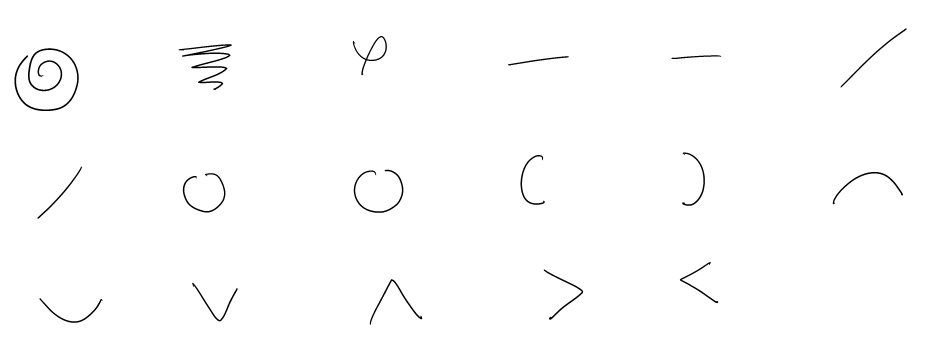Overview
The Synchromedia-Imadoc Gesture New On-Line Database (SIGN-OnDB) contains data corresponding to on-line handwritten gestures. It can be used to train and test gesture recognition systems, used in applications associating specific gestures to edit functions, for example (like copying digital ink elements).
The data was acquired on Tablet PCs and whiteboards.
The gesture set includes 17 different classes. For more information on the data collection protocol, see the corresponding description (file dataset_infos.txt, in the dataset zipfile).
 |
| Examples of the 17 gesture classes |
The database contains forms of unistroke handwritten gestures, stored in InkML format files. Besides the handwritten data, the files also contain information on the acquisition device, on the writer, and on the transcription. For more information on the stored data, see the data format (file dataset_infos.txt, in the dataset zipfile).
Characteristics
The SIGN On-line Database is structured as follows (last update : 04/03/2010):
- 20 contributed writers;
- 78 collected forms;
- 33,150 gesture instances from a 17 gesture dictionary.
Download
The on-line data can be downloaded as a zip file containing all the data as well as information files on the data collected.
Click here to download the zipfile.
The database extracted under the HBF49 representation is a part of the HBF49 database that can be downloaded here
Contact
If you have any questions or suggestions, please contact Eric Anquetil
References
This database can be used freely for research purpose. However, for any published work utilizing this database, please mention a reference to the following paper.
Abdullah Almaksour, Eric Anquetil, Solen Quiniou, Mohammed Cheriet. Personalizable Pen-Based Interface Using Lifelong Learning. In Proceedings of the Twelfth International Conference on Frontiers in Handwriting Recognition (ICFHR’10), Pages 188-193, 2010
On-Line Database IME-OnDB
Overview
IME-OnDB database contains online handwritten data collected in a handwritten Input MEthod and edition tool.
It can be used for training and test of online handwritten recognition systems, and more particularly for
evaluating quality of relative positioning description.
Data samples are organized by pairs of object. A pair is made of a reference object associated to an argument object. Reference object is an isolated handwritten letter from
Latin alphabet. Argument object is a diacritical from French language (accent, cedilla), a punctuation symbol (comma, apostrophe) or an editing gesture (deletion, case switch).
Data was acquired on a Pocket PC.
Database contains 18 classes. The class of a pair of objects is actually the class of the argument object (for example: acute accent, comma, deletion editing gesture),
regardless the reference letter. For more information on the data collection protocol, see the corresponding description (file dataset_infos.txt, in the dataset zipfile).

The database contains unistroke handwritten gestures, stored in a simple ASCII format.
Besides the handwritten data, the files also contain information about the writer identity.
For more information on the stored data, see the data format (file dataset_infos.txt, in the dataset zipfile).
Characteristics
The ACCENT On-line Database is structured as follows (last update: 26/09/2011):
15 contributed writers
18 classes
5,525 records (each record is a pair of objects)
Download
The on-line data can be downloaded as a zip file containing all the data as well as information files on the data collected.
Click here to download the zipfile.
Contact
If you have any questions or suggestions, please contact Eric Anquetil.
